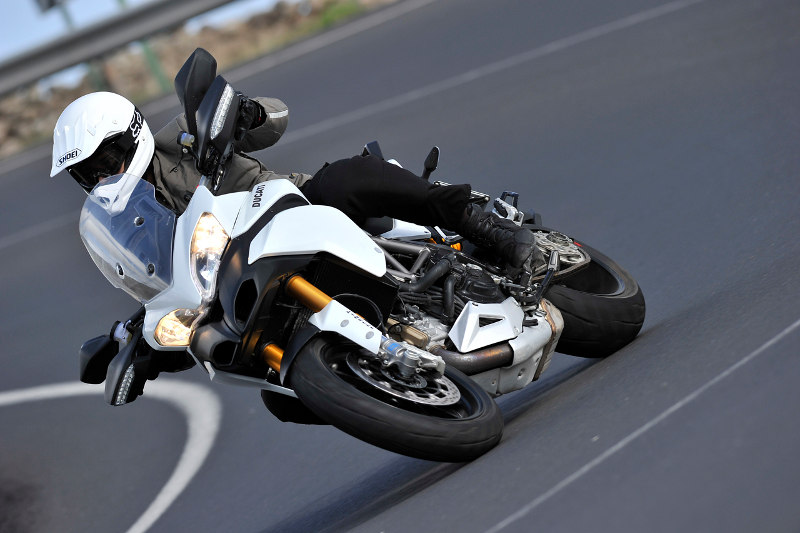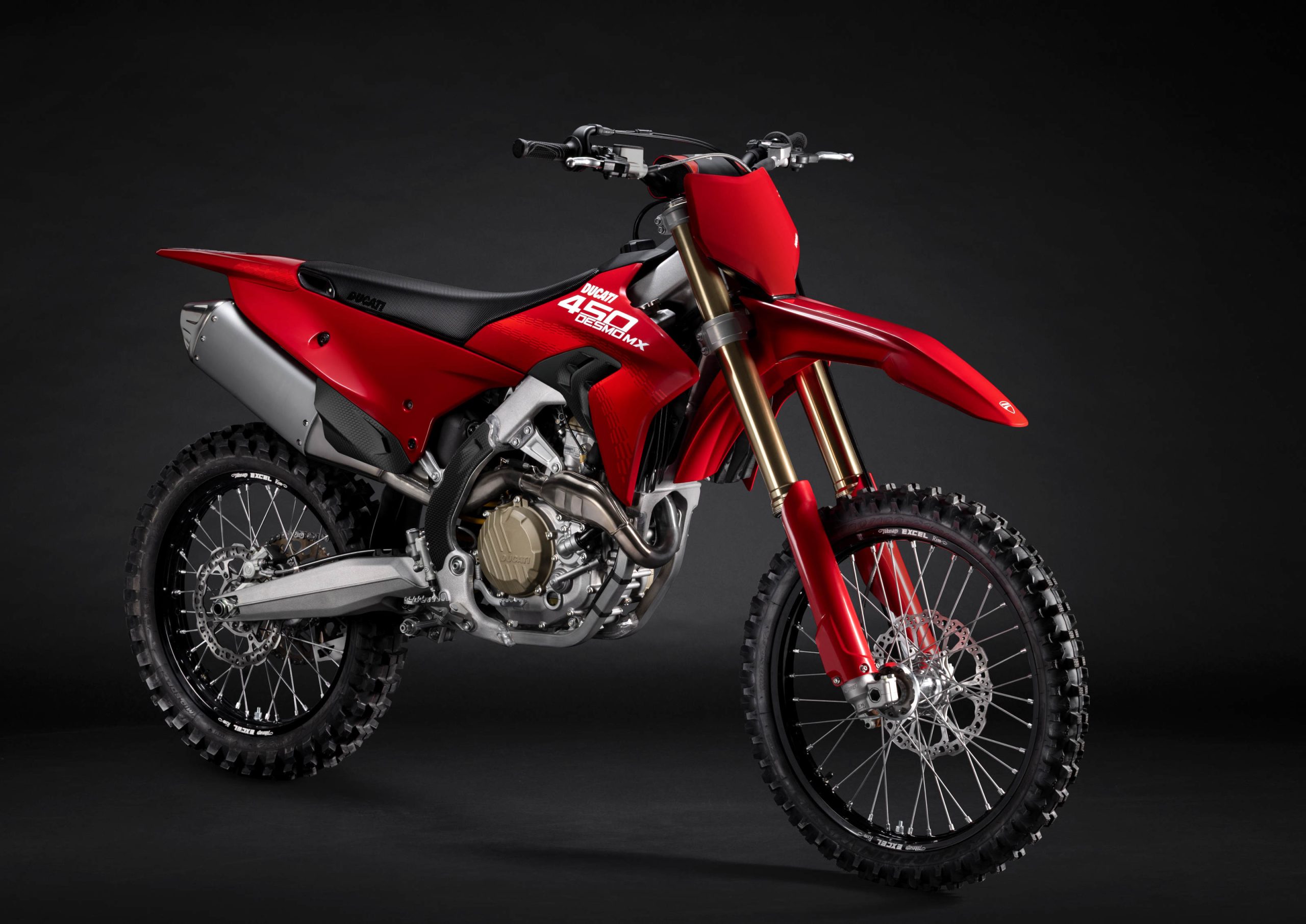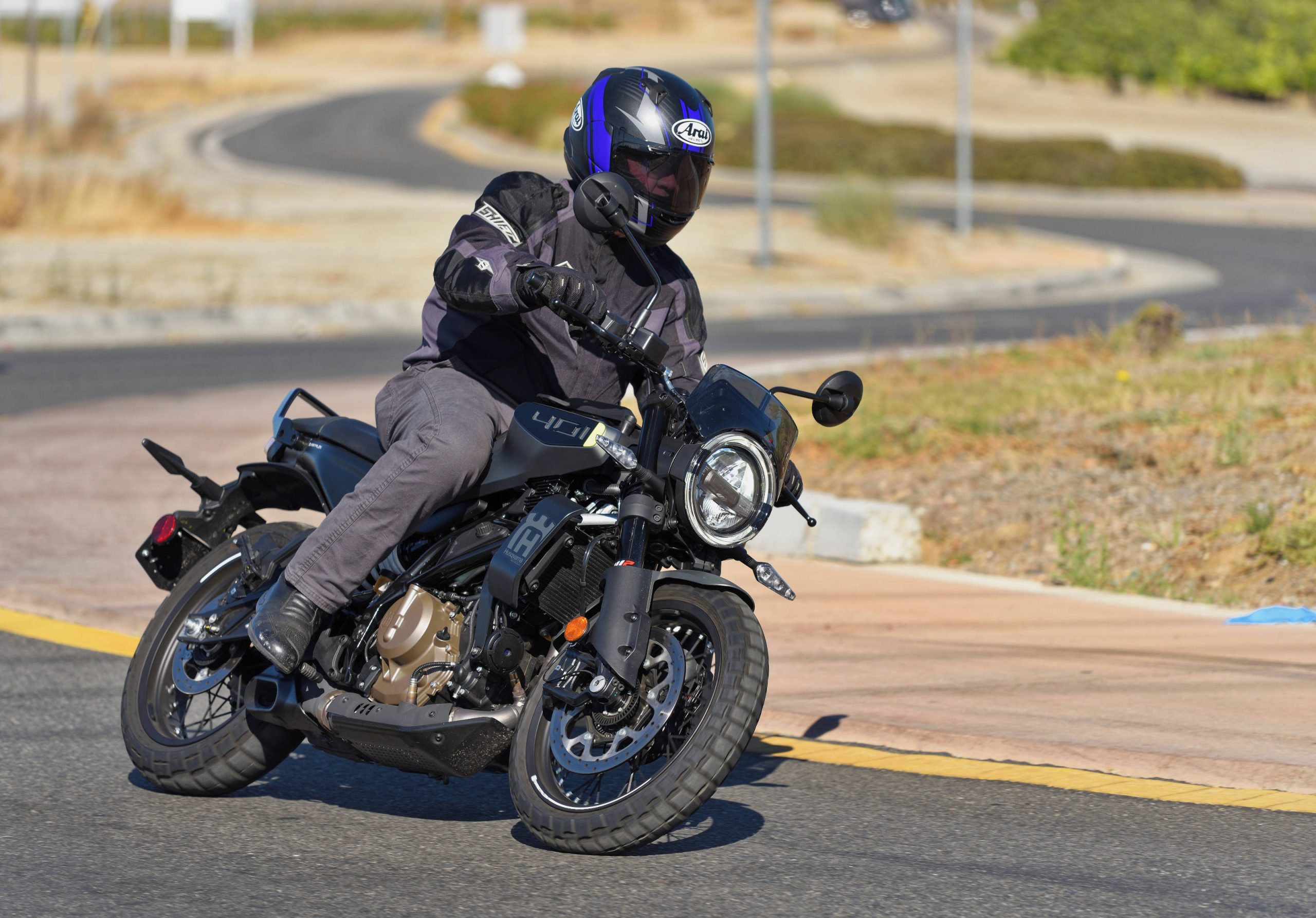
A year ago, the thought of a dual-purpose Ducati would have inspired hearty chuckles from the BMW GS/Suzuki V-Strom/Kawasaki KLR set-despite the fact that the seven year-old “Multistrada” name translates to “many roads.” But after a day of putting the new 2010 Multistrada 1200 through its paces on the Spanish island of Lanzarote, we’re convinced the competition has legitimate cause for concern.
Hearty mechanicals and elaborate electronics make the new ‘Multi ready for more challenging surfaces than you might expect. Adding to the bike’s appeal are sportbike-derived underpinnings which lend it the highest power-to-weight ratio in its segment, along with a re-worked trellis frame that boasts a 19 percent increase in torsional rigidity.
The Multistrada’s liquid-cooled, Desmodromic-valved 1,198cc L-twin churns out 150 horsepower at 9,250 rpm and 87.5 lb-ft of torque at 7,500 rpm, replacing the outgoing Multistrada’s venerable air-cooled engine. The new 1198 superbike-sourced powerplant has been massaged for increased low-end torque, and impressively, the engine produces more twist below 6,500 rpm than its superbike stablemate.
Engine manageability at low rpms is improved thanks to a less aggressive 11 degrees of valve lift overlap and increased engine flywheel mass, and power is diverted to a six-speed transmission that’s mitigated by a wet slipper clutch. Ultra-long distance adventurers and penny pinchers alike will likely appreciate the Multi’s new 15,000 mile engine service interval. The bike’s estimated U.S. fuel economy of 47 mpg equates to a cruising range of 248 miles, thanks to a 5.3 gallon gas tank.

But the most notable of the new Multistrada’s statistics is its wet weight, which ranges from 478 to 485 pounds, depending on equipment. And unlike the outgoing Multistrada’s bare-bones, keep-it-simple mechanicals, the new bike boasts a host of advanced electronics. Priced at $14,995, the base model features ride-by-wire throttle, the same Ducati Traction Control system found on the 1198 S and R, and hands-free ignition, a la Kawasaki’s KIPASS system. A defeatable Bosch-Brembo ABS setup boosts the price to $16,495, and the brakes-with or without ABS-are a serious piece of kit, with radially-mounted, four-piston 320mm discs found up front, and a 245mm disc at the rear. Preload, rebound, and compression-adjustable 50mm Marzocchi forks come with non-“S” models, with a fully adjustable rear Sachs monoshock offering preload settings via an easily reached knob.
“S Sport” and “S Touring” variants bring the MSRP to $19,995. The former adds carbon fiber belt covers, air intakes, and a rear wheel hugger. The latter includes hard saddlebags, heated grips, and a center stand. Both “S” variants feature electronically-controlled Öhlins suspension and traction control. Those variables (as well as throttle mapping) are manipulated into one of four modes, via buttons on the left switchgear. The bike’s personality can be easily switched from “Sport” or “Touring” to “Urban” and “Enduro” modes, each of which offers a pre-set level of throttle response, permissible wheel slip, and suspension firmness, with rear ride height increasing in “Enduro” mode. Power users can wile away the hours tailoring the pre-set values to whichever they choose; for instance, though “Urban” and “Enduro” modes cut engine power to 100 horsepower in default settings, a rider can redefine those parameters for more or less traction control intervention, with the full 150 horsepower on tap. Stock settings are easily reverted to with the push of a button, and preload and rebound can also be manually set, with numerical values displayed on the digital instrument panel.

How do these whiz-bang features translate to the road? Release the low-effort clutch, and the massive twin reciprocating pistons move the Multistrada effortlessly forward. The four riding modes offer a noticeable throttle response off the bat; “Sport” is sharp and aggressive, “Touring” a bit smoother, and “Urban” considerably lazier, but still responsive enough to satisfy under lower speed situations. Similarly, the theme continues to the suspension, with behavior ranging from busy to cushy. Along the smoothly paved roads wrapping around the volcanic landscape of Lanzarote, we tended towards the “Sport” and “Touring” settings, which offered full access to the engine’s 150 horsepower output. Photo passes were best handled in the “Urban” setting, which allowed for more precise speed and line selections, without feeling neutered.

Though the shifter isn’t as slick as the BMW GS’s, the clutch lever is remarkably light, in a manner that echoes the bike’s curb weight. The saddle measures 33.46 inches tall (with a lower, 32.48 inch seat available), but the Multistrada’s light weight makes it easy to handle at stoplights. The saddle was benchmarked against the BMW GS, so we weren’t surprised to find the Multistrada comfortable after a day’s worth of aggressive riding, with an upright posture that felt natural, and wide handlebar position revealing its enduro aspirations. The Beemer was also benchmarked for saddlebag capacity, with the Multistrada coming in at just over 15 gallons, or 20.3 gallons for the large lid version. An available top case adds another 12.7 gallons, and is capable of holding two full-face helmets.
At rest, the Multistrada is also an exercise in thoughtful design, with a manually adjustable windscreen that cuts weight and frees up turning radius, removable saddlebags that barely leave a visual trace of their mounting points, and a well-laid out digital instrument panel that displays a myriad of information ranging from gear selection, tire pressure (on the “S Touring” model), fuel economy and average speed…to air temperature and ride mode settings. For a motorcycle laden with such a comprehensive array of electronic features, accessing and controlling those variables is a surprisingly intuitive task, with switchgear that’s not any more complicated than it needs to be.
After confirming that its superbike origins make it a powerful, nimble sport tourer on the highway, we ventured off the beaten path at the end of our riding day, attacking a severely potholed secondary road in “Enduro” mode. With the ride height increased and the 6.69 inches of suspension travel maximized, the Multistrada absorbed surface irregularities with impressive ease. Though the 17 inch wheel setup isn’t ideal for challenging terrain, the dual compound Pirelli Scorpion Trail tires do a better-than-expected job of keeping the shiny side up when the road gets gritty. We expect engine clearance to be the primary limiting factor for serious offroad excursions, and we noted that the Ducati’s bodywork also feels a touch more precious than the sturdy panels found on the BMW.

But when you venture back onto pavement, the Multistrada reminds you not only of its remarkable athletic abilities, but of the sporting spirit that’s intrinsic to the Ducati brand. In fact, those on-road characteristics-the torquey power of the engine, the flickable handling, the immensely powerful brakes-put the Multistrada’s considerable off-road skillset in perspective, making it all the more impressive.
Ewan McGregor and Charley Boorman still wouldn’t pick the plucky new Duc for a hypothetical third ’round-the-world journey. But for the rest of us whose primary milieu is pavement with a touch of dirt, the Ducati Multistrada 1200 is an impressively well-rounded sport adventure tourer whose available electronic aids make it ready to tackle more rugged trails than you might expect. Considering the Italian manufacturer’s image is so laden with historical baggage-both good and bad-the Multistrada 1200 challenges the past, and redefines the essence of the Ducati brand.

MD Readers Respond:
- Nice article, you guys do a better job than the other online rag I read, motocycle.com. I would say that from a power to weight ratio perspective I’m sure this kicks butt on everything in it’s class. But from an offroad perspective that 17” wheel is extremely limited. I run a number of dual sport events here in Oregon on either a V-Strom or a KLR, and I just don’t expect anyone to be able to ride over a log with that 17” wheel. None the less I’d be happy to own this thing as a bad ass sport tourer that wouldn’t get ruined on a short well maintained dirt road, though investing in some radiator protection and a skid pan is probably a must. Keep up the good work, Bryan





